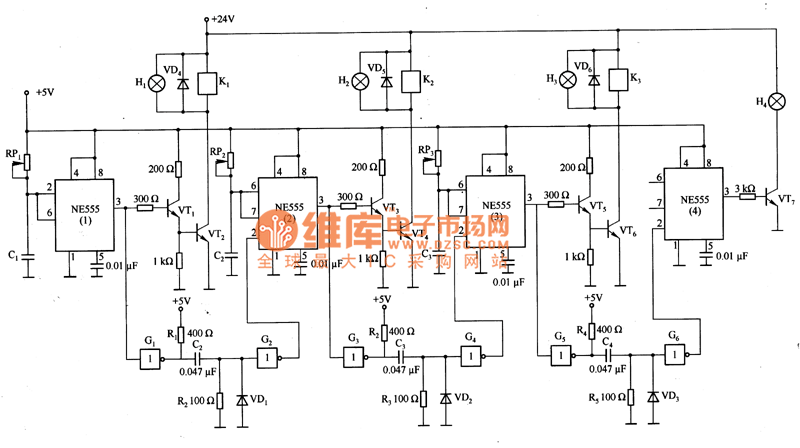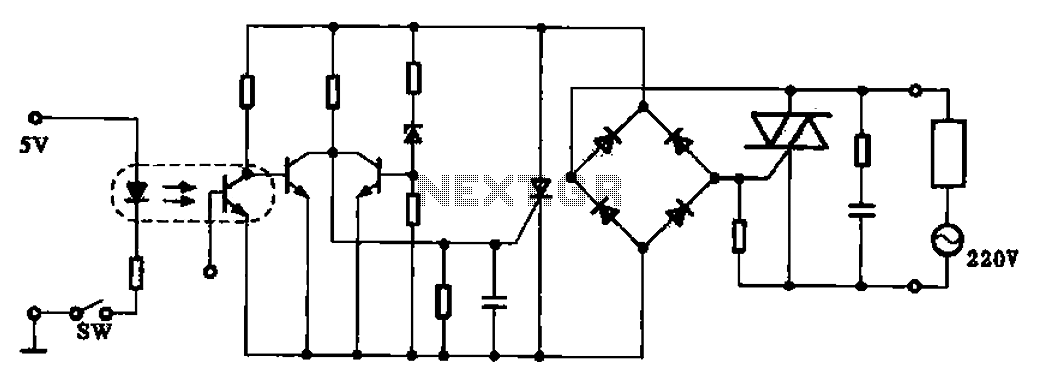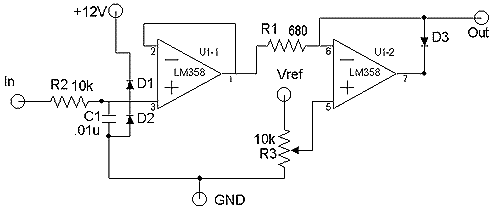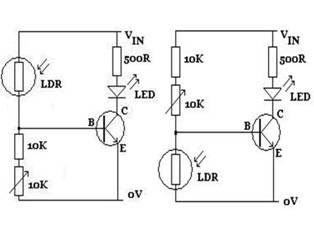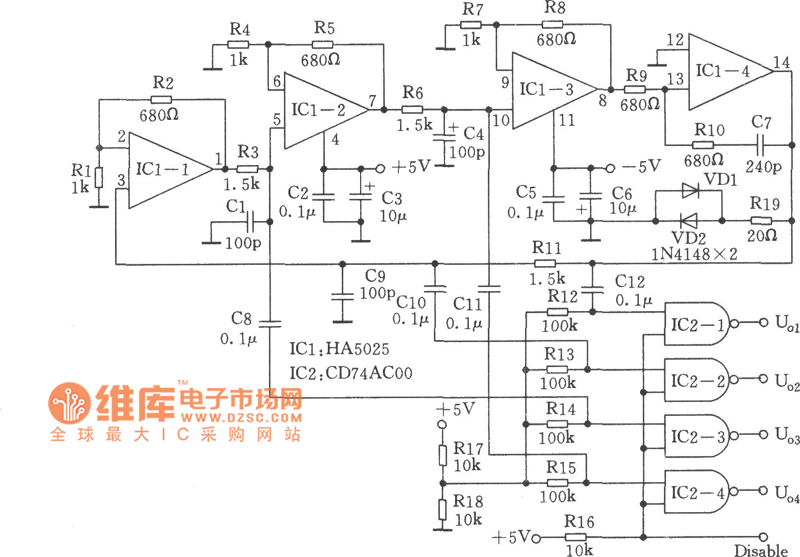
High And Low Voltage Cut Off With Time Delay
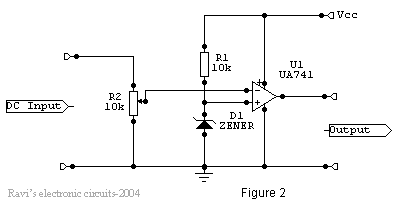
Power line fluctuations and cut-offs can damage electrical appliances connected to the line, particularly domestic appliances such as refrigerators and air conditioners. When a refrigerator operates at low voltage, excessive current flows through the motor, leading to overheating and potential damage. The under/over voltage protection circuit with a time delay described here is a low-cost and reliable solution for protecting such equipment from damage. Upon power line activation, the circuit connects to the appliance only after a fixed delay. If there are high or low fluctuations beyond set limits, the appliance is disconnected. The system attempts to reconnect power after a specific time delay, which is counted from the time of disconnection. If the power outage duration is less than the delay time, power resumes after the delay; if it is equal to or exceeds the delay, power resumes immediately. This circuit has been designed around readily available semiconductor devices, including a standard bipolar medium power NPN transistor (D313/SL100/C1061), an 8-pin type 741 op-amp, and an NE555 timer IC. A notable feature is the absence of relay hunting, a common drawback in commercially available protectors. The complete circuit consists of several stages: a dual rail power supply, a reference voltage source, voltage comparators for high/low cut-offs, a time delay stage, and a relay driver stage.
The circuit begins with a conventional dual rail power supply, where power is applied through a step-down transformer (230/12-0-12V/500mA). The DC voltage proportional to the charging input voltage is obtained from a bridge rectifier. Two electrolytic capacitors are used to bypass any spikes present, and the bridge rectifier can handle currents up to 1 Amp. A zener diode (D1) and its associated resistor (R1) are connected to the non-inverting terminal (+ve) of the 741 op-amp to provide a suitable reference voltage. The DC voltage from the sensor is fed to the inverting terminal (-ve) through a pre-set resistor (R2), which sets the input level. The op-amp operates as an inverted amplifier; when the sensor input is below the zener voltage, the output remains high, and when it exceeds the zener voltage, the output goes low. When the sensing voltage equals the zener voltage, the op-amp output is approximately zero.
The circuit employs a monostable configuration. An external timing capacitor (C2) remains initially discharged by the timer and triggers upon receiving a pulse at pin 2 when the voltage level reaches 1/3 Vcc. The circuit remains in this state until the designated time elapses or power to the circuit is cut off. The delay period in seconds is calculated as 1.1 times C2 multiplied by R1, where R1 is in megohms and C2 is in microfarads. In practice, R1 should not exceed 20 MΩ, and if an electrolytic capacitor is used for C2, a low leakage unit is recommended.
A relay (12V <500 ohms) is connected to the collector of the NPN transistor. The output voltage from the comparator is applied to the base of the NPN transistor through resistor R1. When the comparator output is low, the transistor remains off, and the relay is de-energized. Conversely, when the comparator output goes high, the transistor turns on, allowing current to flow from the collector to the emitter, energizing the relay. Typically, a diode or capacitor is used in parallel with the relay coil to eliminate back EMF generated when current is suddenly interrupted. In this design, a capacitor (C1) is connected in parallel to the coil to filter out back EMF, although it may slow down relay operation. An improved method employs two diodes, which prevent the relay transistor junction from swinging more than 600mV above the positive rail or below the zero-volt rail. During normal operation, these diodes remain reverse-biased, having no effect on circuit performance; however, when back EMF occurs, the diodes conduct heavily, absorbing all transient voltages. Both methods have been implemented in the design.
Under normal operating conditions, when the input voltage is within the maximum and minimum limits, the outputs from both comparators remain low, keeping transistor Q1 off and the relay in a de-energized state (with the pole connected to the normally closed pin). If the input voltage exceeds the limits set by pre-sets R8 or R9, the op-amp outputs either go low or high, forward-biasing diodes D1 or D2 depending on the situation. Transistor Q1 is activated, energizing the relay and cutting off the output. A small amount of hysteresis has been added using feedback resistors R10 and R11 to ensure that the relay turns on when the voltage falls to a specific level but does not turn off until the voltage rises significantly above this threshold, preventing chattering.
The circuit is implemented on a piece of veroboard, which has copper strips on one side for component mounting, and is housed in a discarded ATX PC power supply box. An autotransformer is utilized to set the voltage limits. To establish the high limit, the autotransformer output is set to 250V AC and connected to the primary of transformer T1. Adjust pre-set R9 until the relay just energizes. For the low limit, set the autotransformer output to 200V AC and adjust pre-set R8 until the relay energizes. While these limits are preferred, any range from approximately 170V to 270V AC can be selected. Additionally, a neon indicator with a suitable resistor can be connected between the AC supply lines as an ON indicator, or alternatively, an LED with a current-limiting resistor can be connected across the relay coil to indicate when the relay is energized.The power line fluctuations and cut-offs cause damages to electrical appliances connected to the line. It is more serious in the case of domestic appliances like fridge and air conditioners. If a fridge is operated on low voltage, excessive current flows through the motor, which heats up, and get damaged.
The under/over voltage protection circuit with time delay presented here is a low cost and reliable circuit for protecting such equipments from damages. Whenever the power line is switched on it gets connected to the appliance only after a delay of a fixed time.
If there is hi/low fluctuations beyond sets limits the appliance get disconnected. The system tries to connect the power back after the specific time delay, the delay being counted from the time of disconnection. If the power down time (time for which the voltage is beyond limits) is less than the delay time, the power resumes after the delay: If it is equal or more, then the power resumes directly.
This circuit has been designed, built and evaluated by me to use as a protector for my home refrigerator. This is designed around readily available semi-conductor devices such as standard bipolar medium power NPN transistor (D313/SL100/C1061), an 8-pin type 741 op-amp and NE555 timer IC.
Its salient feature is that no relay hunting is employed. This draw back is commonly found in the proctors available in the market. The complete circuit is consisting of various stages. They are: - Dual rail power supply, Reference voltage source, Voltage comparators for hi/low cut offs, Time delay stage and Relay driver stage. Lets now look at the step-by-step design details. This is a conventional type of power supply as shown in Figure 1. The power is applied through the step-down transformer (230/12-0-12V/500mA). The DC proportional to the charging input voltage is obtained from bridge rectifier. Two electrolytics are there to bypass any spikes present. Bridge is capable of handling currents up to 1 Amp. In this ckt the zener diode D1 and it`s associated resistor R1 are connected to the non-inverting terminal (+ve) of 741 to give the suitable reference voltage.
The DC voltage from the sensor is given to the inverting (-ve) terminal through pre-set R2. This is used to set the input level. When the sensor input is less than Zener voltage the output from the Op-amp remains high and when it is greater than Zener voltage the output goes low. When the sensing voltage is equal to Zener voltage the output of the op-amp is approximately zero. Here the op-amp is used as a inverted amplifier. See Figure 3. Zener and resistor network gives reference voltage to the inverting terminal (-ve) of op-amp. Sensing voltage derived through the 10 K pre-set is given to the non- inverting (+ve) terminal and this sets the high level cut.
When the input DC from the sensor is less than Zener voltage the output of the op-amp is low and vice-versa. When the input DC voltage is equal to the zener voltage, the op-amps output is approximately zero. This is basically a monostable. The external timing capacitor C2 is held initially discharged by the timer. The circuit triggers upon receiving a pulse to its pin 2 when the level reaches 1/3 Vcc. Once triggered. , the circuit will remain in that state until the set time is elapsed or power to the circuit cuts off.
The delayed period in seconds is 1. 1 C2. R1 where R1 is in megohms and C2 is in microfarads. In practice, R1 should not exceed 20 M. If you use an electrolytic capacitor for C2, select a unit for low leakage. The time delay may have to be adjusted by varying R1 to compensate for the wide tolerance of electrolytics. In this a relay (12V <500 ohms) is connected to the collector of NPN transistor. The out put voltage from the comparator is applied to the base of NPN transistor through a resistance R1.
When the output from the comparator is low the transistor is in OFF state and the relay is in de-energized state. Similarly when the output from the comparator goes high the transistor switches ON and the flow of current from the collector to emitter of transistor energizes the relay.
Generally in a relay driver circuit, parallel to the relay coil, a diode or a capacitor is used. This is to eliminate the back e. m. f generated by the relay coil when currents are suddenly broken. Capacitor C1 is connected in parallel to the coil, which filters out the back emf but it, slows down the working of relay. A better method is to connect two diodes (as shown in the figure 5) that stop the relay transistor junction swinging more than 600mV above the positive rail or below the zero-volt rail.
During normal operation the diodes are reverse biased and have no effect on the performance of circuit. But when back emf is induced, the diodes conduct heavily and absorb all transient voltages. However, I have employed the both methods. Under normal operating conditions i. e. when the input voltage is between maximum and minimum limit the output from the both the comparators are low.
The transistor Q1 is OFF and the relay is in de-energized (pole connected to N/C pin) state and the output is obtained. When the input voltage is below or above the limits set by the pre-sets R8 or R9, the output of the Op-Amps goes either low or high and diodes D1 or D2 would be forward biased depending on the situation.
Transistor Q1 switches ON and the flow of current from collector to emitter energizes the relay and the output is cutoff. A small amount of hystersis has been added via feed back resistors R10 & R11 so that the relay turns on when the level falls to a particular value but does not turn again until it raises a substantial amount above this value.
Other wise the relay contacts will frequently turn on/off and produce chattering. 1) I used a piece of varoboard, which has copper strips on one side to mount the components, and housed the entire circuit and the transformer in a discarded ATX PC power supply box. 2) An autotransformer has been used to set the limits. Set the output of the autotransformer to 250V AC and connect it to the primary of transformer T1 (see Figure 1).
Then adjust the pre-set R9 such that relay just energizes. This is the high limit. Next set the output of the autotransformer to 200V AC and adjust the pre-set R8 such that the relay energizes. Please note that these are my preferred limits but you may select any range from say 170 to 270V AC. 3) A neon with a suitable resistor could be connected between the AC supply lines as an ON indicator.
Alternatively, LED with a current limiting resistor could be connected between the relay coil so when the relay is energized LED will indicate the situation. 🔗 External reference
The circuit begins with a conventional dual rail power supply, where power is applied through a step-down transformer (230/12-0-12V/500mA). The DC voltage proportional to the charging input voltage is obtained from a bridge rectifier. Two electrolytic capacitors are used to bypass any spikes present, and the bridge rectifier can handle currents up to 1 Amp. A zener diode (D1) and its associated resistor (R1) are connected to the non-inverting terminal (+ve) of the 741 op-amp to provide a suitable reference voltage. The DC voltage from the sensor is fed to the inverting terminal (-ve) through a pre-set resistor (R2), which sets the input level. The op-amp operates as an inverted amplifier; when the sensor input is below the zener voltage, the output remains high, and when it exceeds the zener voltage, the output goes low. When the sensing voltage equals the zener voltage, the op-amp output is approximately zero.
The circuit employs a monostable configuration. An external timing capacitor (C2) remains initially discharged by the timer and triggers upon receiving a pulse at pin 2 when the voltage level reaches 1/3 Vcc. The circuit remains in this state until the designated time elapses or power to the circuit is cut off. The delay period in seconds is calculated as 1.1 times C2 multiplied by R1, where R1 is in megohms and C2 is in microfarads. In practice, R1 should not exceed 20 MΩ, and if an electrolytic capacitor is used for C2, a low leakage unit is recommended.
A relay (12V <500 ohms) is connected to the collector of the NPN transistor. The output voltage from the comparator is applied to the base of the NPN transistor through resistor R1. When the comparator output is low, the transistor remains off, and the relay is de-energized. Conversely, when the comparator output goes high, the transistor turns on, allowing current to flow from the collector to the emitter, energizing the relay. Typically, a diode or capacitor is used in parallel with the relay coil to eliminate back EMF generated when current is suddenly interrupted. In this design, a capacitor (C1) is connected in parallel to the coil to filter out back EMF, although it may slow down relay operation. An improved method employs two diodes, which prevent the relay transistor junction from swinging more than 600mV above the positive rail or below the zero-volt rail. During normal operation, these diodes remain reverse-biased, having no effect on circuit performance; however, when back EMF occurs, the diodes conduct heavily, absorbing all transient voltages. Both methods have been implemented in the design.
Under normal operating conditions, when the input voltage is within the maximum and minimum limits, the outputs from both comparators remain low, keeping transistor Q1 off and the relay in a de-energized state (with the pole connected to the normally closed pin). If the input voltage exceeds the limits set by pre-sets R8 or R9, the op-amp outputs either go low or high, forward-biasing diodes D1 or D2 depending on the situation. Transistor Q1 is activated, energizing the relay and cutting off the output. A small amount of hysteresis has been added using feedback resistors R10 and R11 to ensure that the relay turns on when the voltage falls to a specific level but does not turn off until the voltage rises significantly above this threshold, preventing chattering.
The circuit is implemented on a piece of veroboard, which has copper strips on one side for component mounting, and is housed in a discarded ATX PC power supply box. An autotransformer is utilized to set the voltage limits. To establish the high limit, the autotransformer output is set to 250V AC and connected to the primary of transformer T1. Adjust pre-set R9 until the relay just energizes. For the low limit, set the autotransformer output to 200V AC and adjust pre-set R8 until the relay energizes. While these limits are preferred, any range from approximately 170V to 270V AC can be selected. Additionally, a neon indicator with a suitable resistor can be connected between the AC supply lines as an ON indicator, or alternatively, an LED with a current-limiting resistor can be connected across the relay coil to indicate when the relay is energized.The power line fluctuations and cut-offs cause damages to electrical appliances connected to the line. It is more serious in the case of domestic appliances like fridge and air conditioners. If a fridge is operated on low voltage, excessive current flows through the motor, which heats up, and get damaged.
The under/over voltage protection circuit with time delay presented here is a low cost and reliable circuit for protecting such equipments from damages. Whenever the power line is switched on it gets connected to the appliance only after a delay of a fixed time.
If there is hi/low fluctuations beyond sets limits the appliance get disconnected. The system tries to connect the power back after the specific time delay, the delay being counted from the time of disconnection. If the power down time (time for which the voltage is beyond limits) is less than the delay time, the power resumes after the delay: If it is equal or more, then the power resumes directly.
This circuit has been designed, built and evaluated by me to use as a protector for my home refrigerator. This is designed around readily available semi-conductor devices such as standard bipolar medium power NPN transistor (D313/SL100/C1061), an 8-pin type 741 op-amp and NE555 timer IC.
Its salient feature is that no relay hunting is employed. This draw back is commonly found in the proctors available in the market. The complete circuit is consisting of various stages. They are: - Dual rail power supply, Reference voltage source, Voltage comparators for hi/low cut offs, Time delay stage and Relay driver stage. Lets now look at the step-by-step design details. This is a conventional type of power supply as shown in Figure 1. The power is applied through the step-down transformer (230/12-0-12V/500mA). The DC proportional to the charging input voltage is obtained from bridge rectifier. Two electrolytics are there to bypass any spikes present. Bridge is capable of handling currents up to 1 Amp. In this ckt the zener diode D1 and it`s associated resistor R1 are connected to the non-inverting terminal (+ve) of 741 to give the suitable reference voltage.
The DC voltage from the sensor is given to the inverting (-ve) terminal through pre-set R2. This is used to set the input level. When the sensor input is less than Zener voltage the output from the Op-amp remains high and when it is greater than Zener voltage the output goes low. When the sensing voltage is equal to Zener voltage the output of the op-amp is approximately zero. Here the op-amp is used as a inverted amplifier. See Figure 3. Zener and resistor network gives reference voltage to the inverting terminal (-ve) of op-amp. Sensing voltage derived through the 10 K pre-set is given to the non- inverting (+ve) terminal and this sets the high level cut.
When the input DC from the sensor is less than Zener voltage the output of the op-amp is low and vice-versa. When the input DC voltage is equal to the zener voltage, the op-amps output is approximately zero. This is basically a monostable. The external timing capacitor C2 is held initially discharged by the timer. The circuit triggers upon receiving a pulse to its pin 2 when the level reaches 1/3 Vcc. Once triggered. , the circuit will remain in that state until the set time is elapsed or power to the circuit cuts off.
The delayed period in seconds is 1. 1 C2. R1 where R1 is in megohms and C2 is in microfarads. In practice, R1 should not exceed 20 M. If you use an electrolytic capacitor for C2, select a unit for low leakage. The time delay may have to be adjusted by varying R1 to compensate for the wide tolerance of electrolytics. In this a relay (12V <500 ohms) is connected to the collector of NPN transistor. The out put voltage from the comparator is applied to the base of NPN transistor through a resistance R1.
When the output from the comparator is low the transistor is in OFF state and the relay is in de-energized state. Similarly when the output from the comparator goes high the transistor switches ON and the flow of current from the collector to emitter of transistor energizes the relay.
Generally in a relay driver circuit, parallel to the relay coil, a diode or a capacitor is used. This is to eliminate the back e. m. f generated by the relay coil when currents are suddenly broken. Capacitor C1 is connected in parallel to the coil, which filters out the back emf but it, slows down the working of relay. A better method is to connect two diodes (as shown in the figure 5) that stop the relay transistor junction swinging more than 600mV above the positive rail or below the zero-volt rail.
During normal operation the diodes are reverse biased and have no effect on the performance of circuit. But when back emf is induced, the diodes conduct heavily and absorb all transient voltages. However, I have employed the both methods. Under normal operating conditions i. e. when the input voltage is between maximum and minimum limit the output from the both the comparators are low.
The transistor Q1 is OFF and the relay is in de-energized (pole connected to N/C pin) state and the output is obtained. When the input voltage is below or above the limits set by the pre-sets R8 or R9, the output of the Op-Amps goes either low or high and diodes D1 or D2 would be forward biased depending on the situation.
Transistor Q1 switches ON and the flow of current from collector to emitter energizes the relay and the output is cutoff. A small amount of hystersis has been added via feed back resistors R10 & R11 so that the relay turns on when the level falls to a particular value but does not turn again until it raises a substantial amount above this value.
Other wise the relay contacts will frequently turn on/off and produce chattering. 1) I used a piece of varoboard, which has copper strips on one side to mount the components, and housed the entire circuit and the transformer in a discarded ATX PC power supply box. 2) An autotransformer has been used to set the limits. Set the output of the autotransformer to 250V AC and connect it to the primary of transformer T1 (see Figure 1).
Then adjust the pre-set R9 such that relay just energizes. This is the high limit. Next set the output of the autotransformer to 200V AC and adjust the pre-set R8 such that the relay energizes. Please note that these are my preferred limits but you may select any range from say 170 to 270V AC. 3) A neon with a suitable resistor could be connected between the AC supply lines as an ON indicator.
Alternatively, LED with a current limiting resistor could be connected between the relay coil so when the relay is energized LED will indicate the situation. 🔗 External reference
Warning: include(partials/cookie-banner.php): Failed to open stream: Permission denied in /var/www/html/nextgr/view-circuit.php on line 713
Warning: include(): Failed opening 'partials/cookie-banner.php' for inclusion (include_path='.:/usr/share/php') in /var/www/html/nextgr/view-circuit.php on line 713
